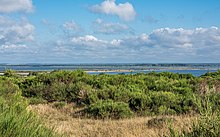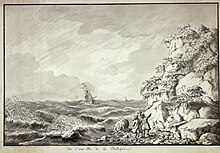Hiddensee
The name Hedinsey surfaces as early as the Prose Edda and the Gesta Danorum written by Saxo Grammaticus and means "Island of Hedin".
[6] A number of artists, writers or even scientists settled in the village or on its outskirts; Kloster has become known as the place of residence of Gerhart Hauptmann, who was buried in the island cemetery there.
As a result of thawing inland ice, the underlying land rose and the hollows filled with water; the predecessor of what became the Baltic Sea, Ancylus Lake emerged.
[10] Hiddensee is the largest island in the Western Pomerania Lagoon Area National Park and blends an old cultural landscape with the wood pastures of the original dune heathland.
[13] The large accumulations of new land in the northeast (Alter and Neuer Bessin) and south (at the Gellen) of Hiddensee offer habitats for numerous invertebrates, such as worms and mussels.
South of Neuendorf lies the so-called Gellen, an important bird reserve that belongs to conservation zone I of the West Pomeranian Lagoon Area National Park and is thus out-of-bounds to the public.
After a large part of the Germanic population had left the southern Baltic region in the 6th century AD, the Rani (Slavs) took possession of the island.
In 1168 the Rans were defeated by King Waldemar I of Denmark by conquering the fortress Jaromarsburg at Cape Arkona on Rügen, Christianized and brought under Danish feudal dependence.
[18][19] Simultaneously with the construction of the monastery, the Gellenkirche, a small beacon called Luchte, and the first harbor were built on the Gellen in the south of the island in the years 1302 to 1306.
During the Thirty Years' War from 1618 to 1648, soldiers burned down the mixed oak forest on the Dornbusch on Wallenstein's orders in 1628, thus depriving the Danes of the opportunity to extract timber.
Until 1861, Hiddensee was virtually treeless for decades, except for the barren willow avenue between the monastery and Grieben and a few pines planted there around 1770, as well as a few trees at Schwedenhagen and Rübenberg.
That the slash-and-burn in 1628 by Wallenstein would have destroyed the forest, as the legend would have it, is unlikely, because already on the map of Rügen by Eilhard Lubin from 1602 no tree symbol is drawn on Hiddensee anymore and the thorn bush is shown as bare hilly land.
The section of coast in front of Vitte was excluded from this, because the Vitter rejected the government's offered reforestation for the reason that access to the beach for tourists would then be impeded.
The most famous is the Karusel in Vitte, built in 1922, which the silent film actress Asta Nielsen bought as a residence in 1928 and for which Bruno Taut had designed the color concept of the house.
In addition to protecting the island, the intention was to limit sand drift in order to save the costs of constant dredging at the Gellen channel and in the Stralsund fairway.
At the end of the 1930s, bunkers and anti-aircraft weapons were built at Enddorn for air defense during World War II, as well as a jetty at Schwedenhagen for material transport.
The bunkers were blown up by the Soviet Army in 1945 (the debris was not removed until the 2000s) and the jetty was developed by VEB Erdöl-Erdgas Grimmen for experimental oil drilling in the 1960s.
[25] The Weiße Flotte Stralsund took over the cooperative shipping company and the fishermen founded the FPG'n De Süder in Neuendorf and Swantevit in Vitte.
Plans include a 135-place yachting harbor, a multipurpose hall, a 5590-square-meter photovoltaic system, a seawater desalination plant in a twelve-meter tower, two piers, an expansion of the ferry dock for cruise ships, and several other buildings.
Between the northern and southern parts of the municipality, an electric regular bus operated by Rügener Personennahverkehrs GmbH (RPNV) runs Monday through Friday.
The island can be reached via several ship connections both from Stralsund (seasonally limited) and from Schaprode on Rügen, operated by the Weiße Flotte "Reederei Hiddensee".
The literature pavilion, built in 2012 in a strikingly modern form on the property, serves as the entrance and houses the ticket office, museum store (bookstore) and a permanent exhibition Literaturlandschaft Hiddensee.
In addition, the house now serves as a museum and artists' residence, where, among other things, the cinematic work of the silent film actress and the life of Max Taut are shown in a permanent exhibition.
The collection of figures and props in the matter-of-fact new building made of larch wood comes mainly from the neighboring puppet theater Seebühne by Karl Huck.
On display, in addition to theater posters and brochures, are, for example, Doctor Faustus, Long John Silver, Ebenezer Scrooge, Hans Christian Andersen, Tolstoy, Kafka, Edgar Allan Poe, William Shakespeare, Goethe, Pinocchio, King Kong, Marilyn Monroe, Helena, and an extensive animal kingdom including a dronte chick.
Six Stolpersteine in Vitte commemorate Henni Lehmann and four other painters of Jewish origin as well as the pedagogue and politician Adolf Reichwein, who became victims of the National Socialist regime.
Even during the GDR era, numerous artists regularly stayed on Hiddensee and reflected on everyday life and the landscape in their paintings, prints and books, such as the writer Hanns Cibulka.
The dancer and dance teacher Gret Palucca spent every summer on Hiddensee from 1948, was given a plot of land in Vitte by the GDR, on which she had a house built in 1961, which was demolished by an investor in 2009.
Palucca was buried in the island cemetery in Kloster, where also lies artistic director Walter Felsenstein, who had a house built opposite the Lietzenburg, where he spent the summer months.
[44] In 1974, Nina Hagen released the hit Du hast den Farbfilm vergessen, which says: "Hoch stand der Sanddorn am Strand von Hiddensee ...".

























